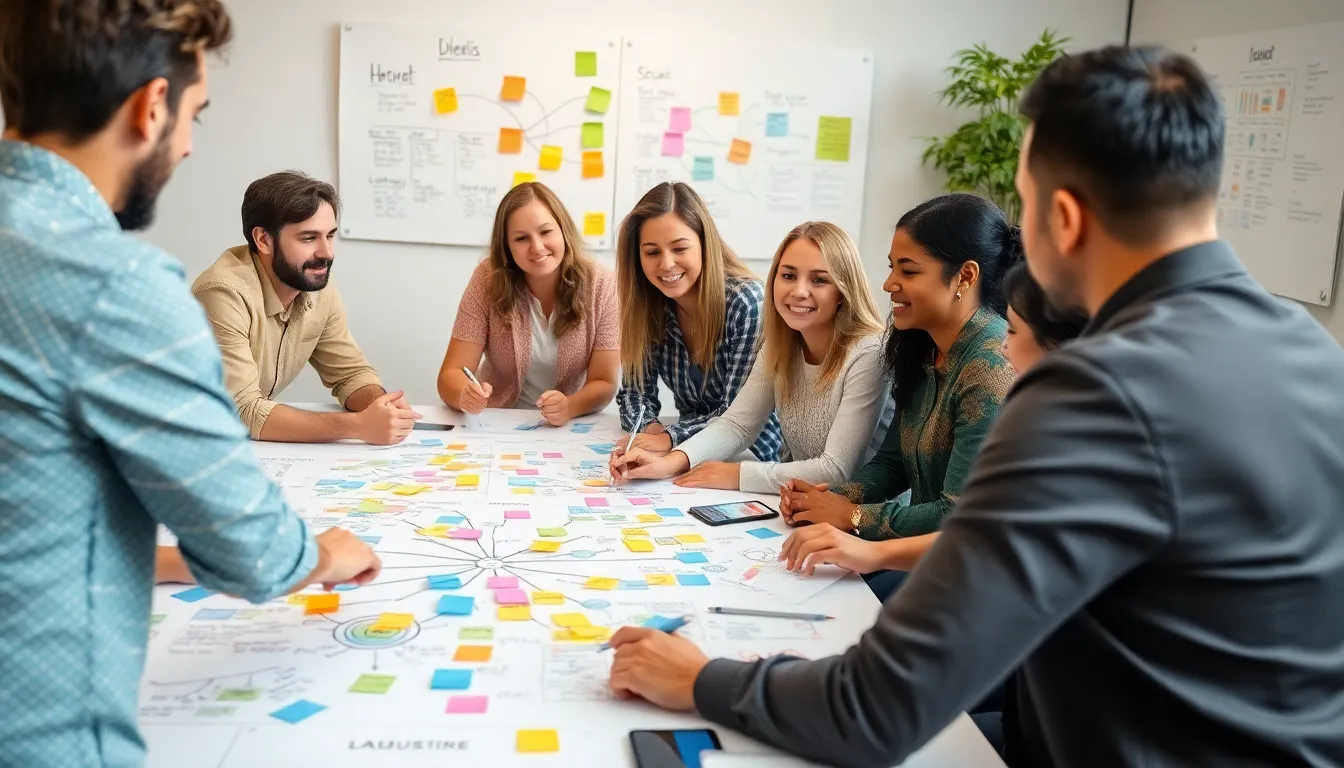In a world where the ordinary often reigns supreme, unleashing creativity can feel like trying to find a unicorn in a haystack. Yet, creative thinking exercises are the magical tools that can help anyone tap into their inner genius. Whether you’re brainstorming for a project or simply looking to spice up your daily routine, these exercises can transform a dull moment into a burst of inspiration faster than you can say “Eureka!”
Table of Contents
ToggleUnderstanding Creative Thinking
Creative thinking involves generating unique ideas and solutions. It contrasts with conventional thought processes, emphasizing innovation and imagination.
Definition of Creative Thinking
Creative thinking refers to the ability to think outside traditional boundaries. It involves generating new ideas, connecting disparate concepts, and seeing problems from fresh perspectives. Critical elements include flexibility, originality, and the willingness to explore imaginative possibilities.
Importance of Creative Thinking
Creative thinking drives progress in various fields, including art, technology, and business. This type of thinking fosters innovation and enhances problem-solving skills. By fostering adaptability, individuals can navigate complex challenges effectively. Engaging in creative thinking stimulates personal and professional growth, enabling people to approach situations with a renewed sense of inspiration.
Types of Creative Thinking Exercises

Creative thinking exercises come in various forms, each designed to stimulate ingenuity and inspire fresh ideas. The following subsections outline several effective types.
Brainstorming Techniques
Brainstorming techniques promote idea generation through group collaboration. Using prompts, participants share thoughts freely, without judgment. Techniques like rapid brainstorming involve timed sessions for spontaneous idea flow. Another method, reverse brainstorming, identifies potential problems instead of solutions, encouraging unique perspectives. Integrating mind maps during the sessions can visually organize ideas, aiding in exploration and enhancing connections.
Role-Playing Scenarios
Role-playing scenarios allow individuals to immerse themselves in different perspectives. Participants assume various roles, enabling them to explore situations creatively. For example, taking on the persona of a customer can unveil valuable insights about product development. Additionally, using structured role-playing games can foster teamwork and creative problem solving. Engaging in these scenarios encourages thinking beyond usual frameworks while generating innovative solutions.
Mind Mapping Activities
Mind mapping activities provide a visual approach to organizing thoughts. Starting with a central idea, branches expand into related concepts, creating a comprehensive overview. This technique facilitates connections between disparate ideas and enhances understanding of complex subjects. Creating digital mind maps can streamline collaboration, allowing input from multiple participants. Engaging in these activities encourages lateral thinking, essential for uncovering hidden insights.
Benefits of Creative Thinking Exercises
Creative thinking exercises provide numerous advantages that enhance personal and professional development. These benefits include improved problem-solving skills, better collaboration, and heightened innovation.
Enhanced Problem-Solving Skills
Creative thinking exercises equip individuals with effective problem-solving skills. Practicing these exercises leads to a broader perspective on challenges, enabling the exploration of unconventional solutions. By applying techniques like brainstorming or mind mapping, one can visualize problems and identify various approaches. These methods encourage adaptive thinking, allowing individuals to tackle obstacles with confidence. Enhanced problem-solving abilities result in quicker resolutions and foster a proactive attitude toward challenges. This proactive mindset drives efficiency and fosters resilience in both personal and professional settings.
Improved Collaboration and Teamwork
Engagement in creative thinking exercises bolsters collaboration and teamwork among group members. Sharing innovative ideas stimulates communication and strengthens relationships within teams. Utilizing role-playing scenarios exposes individuals to diverse viewpoints, promoting understanding and empathy. This improved dynamic fosters a culture of collaboration where teammates build upon each other’s ideas. When team members feel valued, they contribute more actively to discussions, resulting in richer project outcomes. Enhanced collaboration ultimately leads to innovative solutions that benefit organizations in competitive landscapes.
Increased Innovation and Creativity
Participating in creative thinking exercises significantly boosts innovation and creativity. Exposure to various brainstorming techniques inspires fresh ideas and encourages lateral thinking. Individuals often discover new approaches in their fields, leading to groundbreaking projects and concepts. This increase in inventive thinking drives continuous improvement and innovation within organizations. A culture that nurtures creativity attracts talent and keeps teams engaged. By prioritizing creative exercises, businesses cultivate an environment where innovative solutions thrive.
Implementing Creative Thinking Exercises
Creative thinking exercises thrive in environments that encourage exploration and experimentation. Prioritizing a space filled with inspiring materials, such as art supplies and books, enhances creativity. Incorporating comfortable seating and diverse resources influences how individuals approach problems. Natural light and minimal distractions amplify focus and imagination. Encourage open dialogue and the sharing of ideas to foster collaboration.
Timing plays a crucial role in maximizing the benefits of creative thinking exercises. Dedicating specific times for these activities helps integrate them into routines. Short, frequent sessions often yield more innovative outcomes than sporadic, lengthy ones. Scheduling exercises to align with project deadlines can spark fresh insights. Engaging in creativity daily or weekly keeps the mind active, ensuring a steady flow of ideas.
Embracing creative thinking exercises can transform how individuals approach challenges and opportunities. By fostering an environment that encourages exploration and experimentation, they can unlock a wealth of innovative ideas. Regular engagement in these exercises not only enhances problem-solving skills but also cultivates collaboration and boosts overall creativity.
Whether through brainstorming techniques role-playing scenarios or mind mapping activities, these tools empower individuals to think beyond conventional boundaries. Ultimately, integrating creative thinking into daily routines paves the way for continuous growth and progress in both personal and professional realms. The journey toward creativity is ongoing and rewarding, inviting everyone to discover their unique potential.



